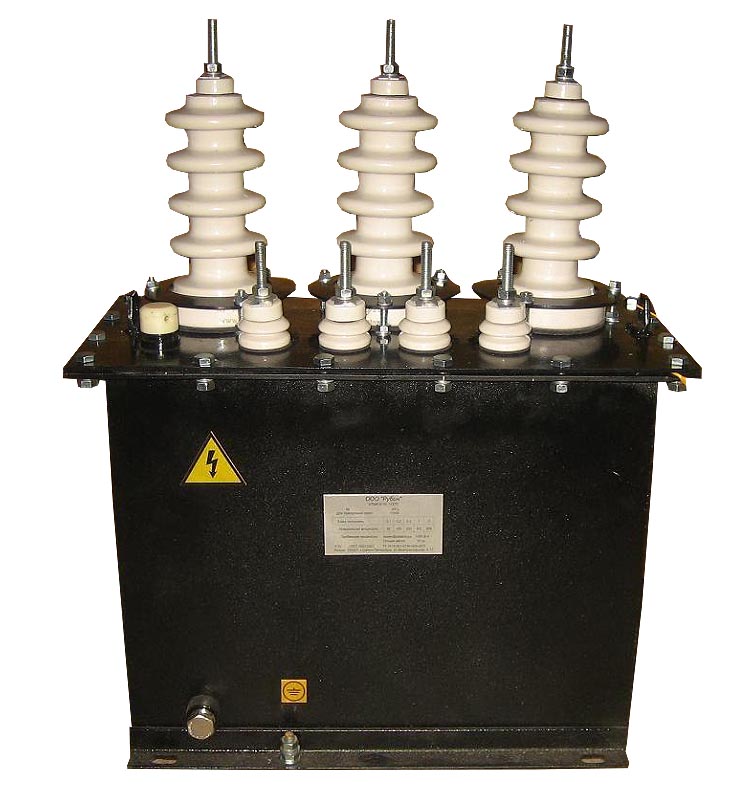To understand what constitutes a loss of electricity in electrical networks, you need to understand the power supply system itself. It consists of a number of structural elements, each of which, under certain conditions, contributes to non-productive costs. In addition, they may be associated with the need to meet their own needs for auxiliary equipment of substations. From this it follows that it is practically impossible to do without losses in electrical circuits.
Types and structure
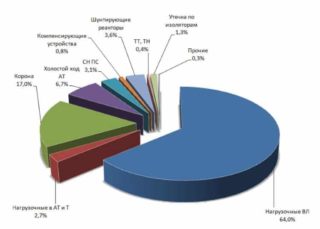
Losses in power grids from the point of view of energy saving are the difference between the electricity supplied by the supplier and the energy that the consumer actually receives. In order to standardize and calculate their real value, the following classification was adopted:
- losses of a technological nature;
- operating (commercial) costs;
- actual overhead.
Technical losses are due to the peculiarities of the laying of power supply lines, as well as the dissipation of energy at the contacts. This also includes the selection of part of the supplied electrical energy for the needs of auxiliary equipment. The technological component includes the costs in the load circuits and the climatic component.
The second factor - commercial - is usually associated with such unrecoverable reasons as the error of instruments that measure the controlled parameters. It also takes into account a number of nuances related to erroneous consumption readings and energy theft.
The studies carried out convincingly prove that the maximum level of costs falls on the transmission of energy by high-voltage transmission lines (up to 64 percent).

Most of them are expenses for air ionization due to coronary discharge (17%). The actual losses are called losses, which were determined at the very beginning - the difference between the released product and its consumed volume. With their simplified calculation, sometimes the two described components simply add up. However, in practice, the technique for calculating this indicator turns out to be somewhat different. To determine it, a time-tested methodology for calculating losses in wires is used, taking into account all other components.
Their actual value according to a special formula is equal to the flow of energy into the network minus the following components:
- the volume received by a private consumer;
- flows to other branches of the power system;
- own technological needs.
Then the result is divided by the amount of electricity entering the grid minus consumption in loads where there are no losses, minus flows and auxiliary needs. At the final stage of the settlement operation, the final figure is multiplied by 100%. If you want to get the result in absolute values, using this method is limited to calculating only one numerator.
Determination of load without overhead
In the previously considered formula, the concept of lossless load is introduced, which is determined by means of commercial metering devices installed at substations.Any enterprise or government organization independently pays for losses in the electrical network, recorded by a separate meter at the connection point. “Flows” are also referred to the category of energy consumption without losses (it is more convenient to calculate this way). They mean that part of it that is redirected from one power system to another. To account for these volumes, separate measuring instruments are also used.
Own needs

Own needs are usually categorized as actual losses. In this indicator, it is customary to fix the costs of maintaining the health of the following objects:
- substations with transformers installed in them;
- administrative buildings, auxiliary buildings, etc.
Each of the articles is included in the total amount in the proportion normalized for this type of consumer.
The most significant contribution is made by regional substations, since they house the main service equipment. It ensures the normal operation of the nodes responsible for the transformation of electricity, as well as its delivery to the consumer.
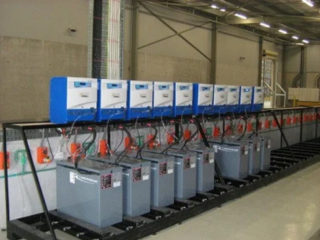
To fix the value of these costs, substations install their own metering devices.
A list of consumers traditionally belonging to the category in question:
- ventilation systems that guarantee complete cooling of a set of transformer equipment;
- heating and ventilation systems for technological rooms, as well as lighting networks installed in them;
- lighting devices located in sectors and territories adjacent to substations;
- equipment of premises for battery charging;
- heating systems for outdoor installations (for controlling air switches, in particular);
- compressors and accessories.
This type of equipment includes devices and tools used for repair work, as well as for the restoration of auxiliary equipment.
Commercial component
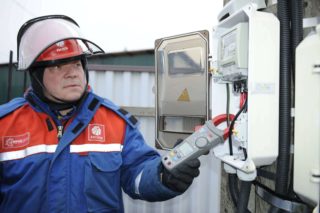
First of all, this component concerns the characteristics of metering devices belonging to end users (their errors, in particular). To reduce this type of loss, a number of specific measures have been developed that have been successfully applied in practice. The category of commercial includes not only errors in billing a specific consumer, but also unaccounted for theft of electricity. In the first case, they most often occur for the following reasons:
- the contract for the supply of electricity contains incomplete or not entirely correct information about the consumer and the balance sheet belonging to the object assigned to him;
- error in indicating the selected tariff;
- lack of control over the operation of metering devices (this case is typical for garden cooperatives and SNT, in particular);
- inaccuracies arising from the correction of previously issued invoices, etc.
Typical errors caused by the controversial definition of the boundaries of the balance sheet ownership of the object are resolved in the manner prescribed by the legislation of the Russian Federation.
The problem of theft is difficult to solve in all civilized countries. These illegal actions are constantly suppressed by the relevant authorities, cases on them are sent to local courts. The peak of such thefts traditionally falls on the winter season and it is in those regions of the country where there are problems with centralized heat supply.
This only confirms the interconnectedness of the commercial components of costs for each of the categories of energy resources.
The main causes of power leaks
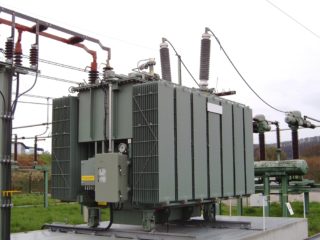
A competent approach to calculating electricity losses implies taking into account the reasons why they arise.When investigating a problem, you should separate the sources of waste in accordance with the already familiar classification. You should start with the technical component, which is usually associated with the following elements:
- transformers;
- high voltage cable or overhead line;
- line service equipment.
Any power transformer has several windings, the frame of which is attached to a ferromagnetic core. In it, most of the electricity is lost, which is transformed into heat (it then simply dissipates into space).
The amount of losses in various elements of the power grid is also influenced by its operating mode: idle or "under load". In the first case, they are assessed as constant, independent of internal and external factors. When a consumer is connected, the level of losses depends on the value of the load current in the circuit, which changes every day. Therefore, to evaluate it, static observations are carried out for a certain period (for a month, for example).
Losses in explosives of power lines are formed during the transportation of an energy carrier due to leaks associated with corona discharge, as well as due to heating of conductors. The category of service equipment includes installations and devices involved in the generation, transportation, as well as in the accounting and consumption of supplied energy. The values of excess losses in this category generally do not change over time or are taken into account by means of electricity meters.
The concept of a normative indicator
This term is understood as a confirmed in practice and economically justified amount of losses for a certain period of time. When approving the standard, all the previously considered components are taken into account, for each of which a separate analysis is carried out. Based on their results, the actual (absolute) value is calculated and possible options for reducing this indicator are considered.
The normalized value does not remain constant all the time - it is continuously corrected.
In this case, absolute indicators mean the difference between the power transmitted to the consumer and technological (variable) losses. The normative values for the last parameter are calculated according to the corresponding formulas.
Who pays for the loss of electricity
To determine who should pay for the overhead in the network, you should take into account the specific situation, as well as a number of additional criteria. When it comes to the costs of replenishing technological losses, their payment falls on the shoulders of consumers - individuals or legal entities.
It is not taken into account directly, but is included in the existing tariffs.
Each consumer, when paying bills for electricity, pays with the grid organization for all kinds of losses in transmission lines and transformers. In the case of the commercial component, the company that sells the energy resource to the client has to pay for any excess of the indicator in excess of the normalized value.
Ways to reduce losses
- optimization of circuit solutions and operating modes of the power grid;
- study of statistical data and identification of nodes of maximum loads;
- reduction of the total power pumped through the network due to an increase in the reactive component;
- optimization of transformer load lines;
- upgrading equipment and applying different approaches to load balancing.
These measures allow to significantly reduce the total consumption and losses and ensure high quality of the voltage in the network (it will not "sag").
Calculation method and example
The following techniques are known for the approximate calculation of losses in power lines:
- operational calculations;
- daily calculations;
- determination of maximum losses for a certain period of time;
- use of aggregated data.
Full information on the officially approved methods for determining this parameter can be found in the relevant regulatory documents.
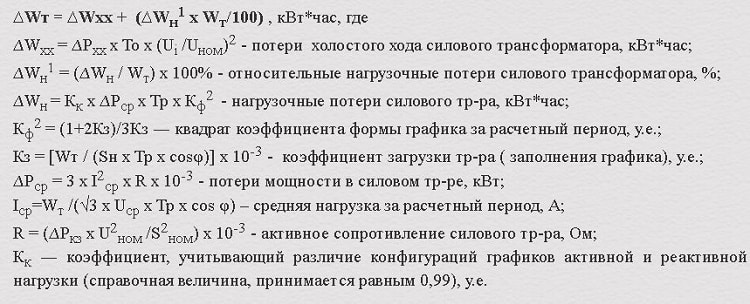
As an example, consider the calculation of losses in a high-voltage line feeder with a transformer TP 6-20 / 04kV.
When implementing the method of online calculation of costs, depending on the linear voltage drop, the phase potentials on the buses of the transformer substation are first measured at the most distant point at the maximum load. According to the results of the measurements, the absolute and relative decrease in DU in percent is recognized: it is taken in relation to its average phase value on the 0.4 kV TP 6-20 buses.
The energy loss W in the 0.4 kV line (as a percentage of the shipment of electricity to the network) can be found by the following formula:
W = 0.7 Kn x DU x t / T, Where
- Кн - coefficient taking into account phase imbalance or uneven distribution among consumers;
- U is the voltage loss in the load (at the most distant point of the line, that is, according to the calculated maximum);
- T is the observation time (in hours);
- t is the value of the time dimension, which characterizes the filling of the schedule for checking the transmission of useful power to the consumer.
Having selected the values of the parameters for a specific feeder according to one of the tables laid out on the Internet (TP-4) and substituting them into the formula, using a calculator, we obtain a value of 11.4 percent.
For feeders of other brands, the required value of technological losses can be calculated using the same tables with the data given in them.
A wide variety of online payment methods are widely represented on the Internet, which anyone can use if necessary.



